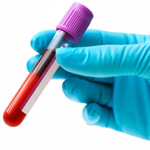 Increased screening and technological advances in breast imaging have led to earlier detection of breast cancer. Although this progress is beneficial, questionable or ambiguous breast images often require a follow-up biopsy, even if they end up being false positive results. BI-RADS (Breast Imaging Reporting and Data System), the current system of categorizing breast imaging findings and their subsequent diagnostic recommendations, was established by the American College of Radiology and is used to calculate accuracy statistics. If a mammogram is classified as BI-RADS 3, the recommended course of action is a 6-month follow-up mammogram which, for the patient, can be a very anxiety-provoking half a year. On the other hand, BI-RADS 4 indicates the need for a biopsy in order to establish a definitive diagnosis. Since the BI-RADS 4 mammogram has a positive predictive value of about 30%, up to 70% of these biopsies end up being benign which can be considered over-treatment in the majority of cases not to mention the unnecessary pain, expense and fear factor involved. However, few women with a BI-RADS 4 mammogram result would take the chance of refusing a follow-up biopsy, just in case they fall into that 30% chance of malignancy.
Increased screening and technological advances in breast imaging have led to earlier detection of breast cancer. Although this progress is beneficial, questionable or ambiguous breast images often require a follow-up biopsy, even if they end up being false positive results. BI-RADS (Breast Imaging Reporting and Data System), the current system of categorizing breast imaging findings and their subsequent diagnostic recommendations, was established by the American College of Radiology and is used to calculate accuracy statistics. If a mammogram is classified as BI-RADS 3, the recommended course of action is a 6-month follow-up mammogram which, for the patient, can be a very anxiety-provoking half a year. On the other hand, BI-RADS 4 indicates the need for a biopsy in order to establish a definitive diagnosis. Since the BI-RADS 4 mammogram has a positive predictive value of about 30%, up to 70% of these biopsies end up being benign which can be considered over-treatment in the majority of cases not to mention the unnecessary pain, expense and fear factor involved. However, few women with a BI-RADS 4 mammogram result would take the chance of refusing a follow-up biopsy, just in case they fall into that 30% chance of malignancy.
Two recent clinical trials were conducted to test the efficiency of a blood-based proteomic biomarker assay called Videssa Breast and its potential role in conjunction with imaging to reduce unnecessary follow-up medical procedures in the case of equivocal imaging results1. Though this type of blood test is not yet established enough to be a stand alone prognostic tool, the trial results have shown it to have a very valuable role when used together with mammograms or MRIs to help winnow out false positive and false negative results. A study population of 545 women under 50 years of age who were reported as BI-RADS 3 or 4 were enrolled to test the validity of the Videssa Breast assay. Blood samples were taken after imaging and were evaluated for 11 serum biomarkers and 33 tumor-associated autoantibodies. Based on the imaging alone, 339 patients received further procedures such as biopsies or cyst aspirations yet of these 339 women, a total of 30 were diagnosed with cancer meaning 309 were false positives2. If the results of Videssa Breast had been used as a basis for these medical decisions, it would have recommended only 111 procedures of which 83 would have been false positives. This indicates that if both prognostic tools were used together, there would have been up to 67% fewer unnecessary biopsies in this specific population.
Certain limitations of this study cannot be ignored. Any biopsy is subject to sampling bias. In other words, if the sample is taken from a region of the breast adjacent to malignancy but not containing abnormal cells, there can be an incorrect benign diagnosis or a “false” false positive result. In addition, patient follow-up was limited to 6 months instead of 12 months which may not be long enough for all the cancers in these BI-RADS 3 and BI-RADS 4 patients to develop. However, there are clear advantages of using this noninvasive tool in conjunction with imaging in women under the age of 50 with equivocal imaging findings. The trend in medicine today is increasingly looking towards pinpointing the genomic and proteomic infrastructure of complex diseases so hopefully by incorporating increased data and longer term studies, we may one day be able to detect breast cancer with a simple blood test.
See the full text of the clinical trial article.
1. “A Noninvasive Blood-based Combinatorial Proteomic Biomarker Assay to Detect Breast Cancer in Women Under the Age of 50 Years.” Lourenco, Ana P. et al. Clinical Breast Cancer, Volume 17 , Issue 7 , 516 – 525.e6
2. An actual total of 32 women were diagnosed with breast cancer; however in one BI-RADS 3 subject, the diagnosis was only discovered during the 6 month follow-up mammogram and the other BI-RADS 4 subject was subsequently upgraded from low-grade DCIS to a grade 2 BC. In both cases, the Videssa Breast test result correctly showed up as positive for breast cancer.


